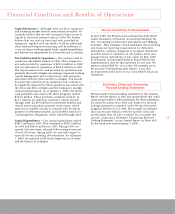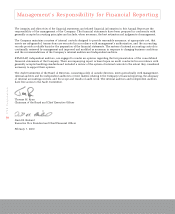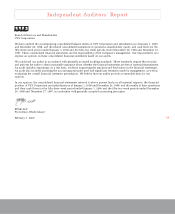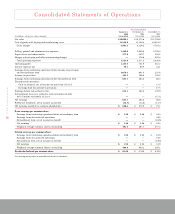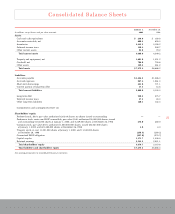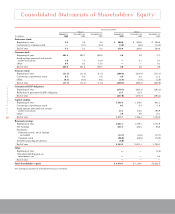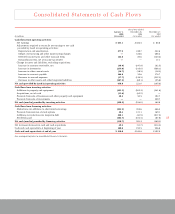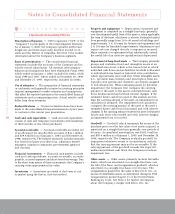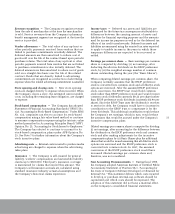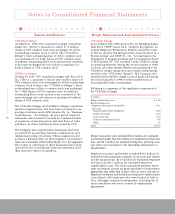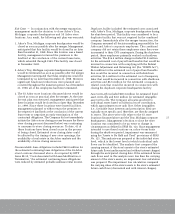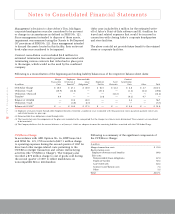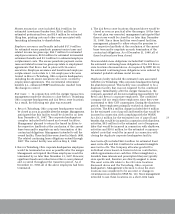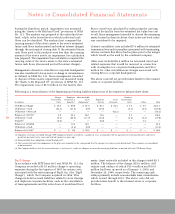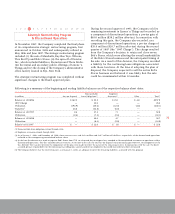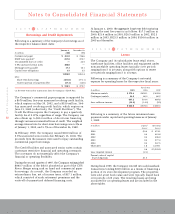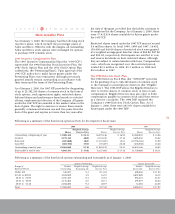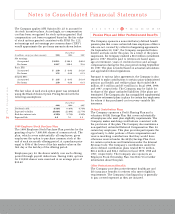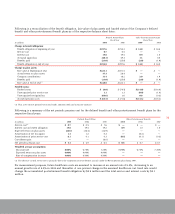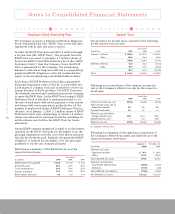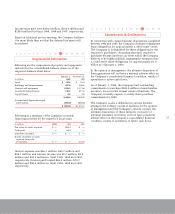CVS 1999 Annual Report Download - page 29
Download and view the complete annual report
Please find page 29 of the 1999 CVS annual report below. You can navigate through the pages in the report by either clicking on the pages listed below, or by using the keyword search tool below to find specific information within the annual report.
27
Exit Costs ~ In conjunction with the merger transaction,
management made the decision to close Arbor’s Troy,
Michigan corporate headquarters and 55 Arbor store
locations. As a result, the following exit plan was executed:
1. Arbor’s Troy, Michigan corporate headquarters would be
closed as soon as possible after the merger. Management
anticipated that this facility would be closed by no later
than December 31, 1998. Since this location was a leased
facility, management returned the premises to the
landlord at the conclusion of the current lease term,
which extended through 1999. This facility was closed
in December 1998.
2. Arbor’s Troy, Michigan corporate headquarters employees
would be terminated as soon as possible after the merger.
Management anticipated that these employees would be
terminated by no later than December 31, 1998. However,
significant headcount reductions were planned and
occurred throughout the transition period. As of December
31, 1998, all of the employees had been terminated.
3. The 55 Arbor store locations discussed above would be
closed as soon as practical after the merger. At the time
the exit plan was executed, management anticipated that
these locations would be closed by no later than December
31, 1999. Since these locations were leased facilities,
management planned to either return the premises to
the respective landlords at the conclusion of the current
lease term or negotiate an early termination of the
contractual obligations. The Company did not immediately
initiate the Arbor store closing process because the Revco
store closing process (discussed below) was continuing
to consume its store closing resources. To date, 41 of
these locations have been closed or are in the process
of being closed. Estimated store closing dates could
be affected by the timing of new store openings, the
availability of real estate in the Arbor markets and the
availability of store closing resources.
Noncancelable lease obligations included $40.0 million for
the estimated continuing lease obligations of the 55 Arbor
store locations discussed above. As required by EITF
Issue 88-10, “Costs Associated with Lease Modification or
Termination,” the estimated continuing lease obligations
were reduced by estimated probable sublease rental income.
Duplicate facility included the estimated costs associated
with Arbor’s Troy, Michigan corporate headquarters during
the shutdown period. This facility was considered to be a
duplicate facility that was not required by the combined
company. Immediately after the merger transaction, the
Company assumed all decision-making responsibility for
Arbor and Arbor’s corporate employees. The combined
company did not retain these employees since they were
incremental to their CVS counterparts. During the shutdown
period, these employees primarily worked on shutdown
activities. The $16.5 million charge included $1.8 million
for the estimated cost of payroll and benefits that would be
incurred in connection with complying with the Federal
Worker Adjustment and Retraining Act (the “WARN Act”),
$6.6 million for the estimated cost of payroll and benefits
that would be incurred in connection with shutdown
activities, $1.5 million for the estimated cost of temporary
labor that would be incurred in connection with shutdown
activities and $6.6 million for the estimated occupancy-
related costs that would be incurred in connection with
closing the duplicate corporate headquarters facility.
Asset write-offs included $38.2 million for estimated fixed
asset write-offs and $3.0 million for estimated intangible
asset write-offs. The Company allocates goodwill to
individual stores based on historical store contribution,
which approximates store cash flow. Other intangibles
(i.e., favorable lease interests and prescription files) are
typically store specific and, therefore, are directly assigned
to stores. The asset write-offs relate to the 55 store
locations discussed above and the Troy, Michigan corporate
headquarters. Management’s decision to close the store
locations was considered to be an event or change in
circumstances as defined in SFAS No. 121. Since management
intended to use these locations on a short-term basis
during the shutdown period, impairment was measured
using the “Assets to Be Held and Used” provisions of SFAS
No. 121. The analysis was prepared at the individual store
level, which is the lowest level at which individual cash
flows can be identified. The analysis first compared the
carrying amount of the store’s assets to the store’s estimated
future cash flows (undiscounted and without interest charges)
through the anticipated closing date. If the estimated future
cash flows used in this analysis were less than the carrying
amount of the store’s assets, an impairment loss calculation
was prepared. The impairment loss calculation compared
the carrying value of the store’s assets to the store’s estimated
future cash flows (discounted and with interest charges).


